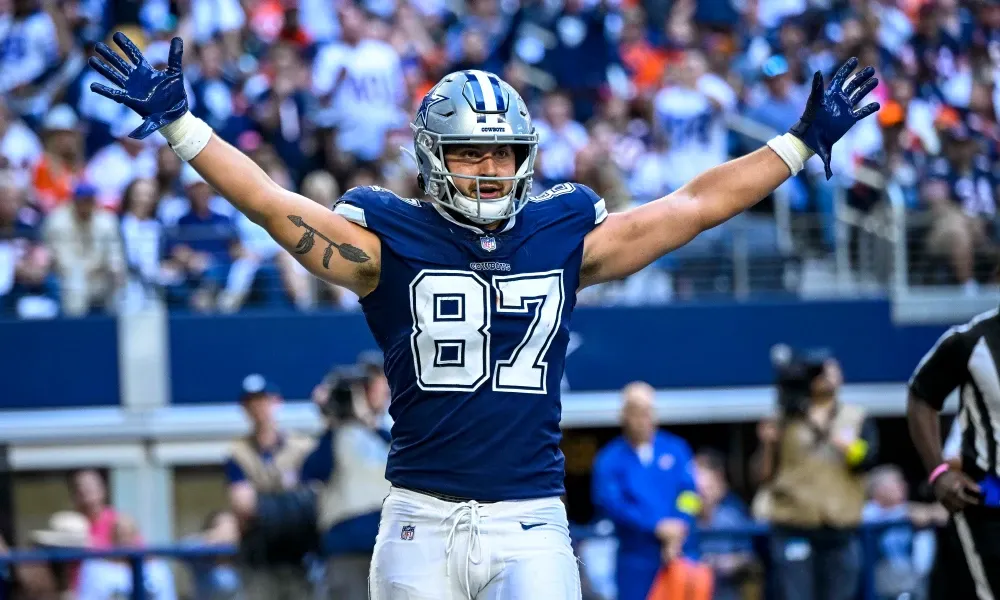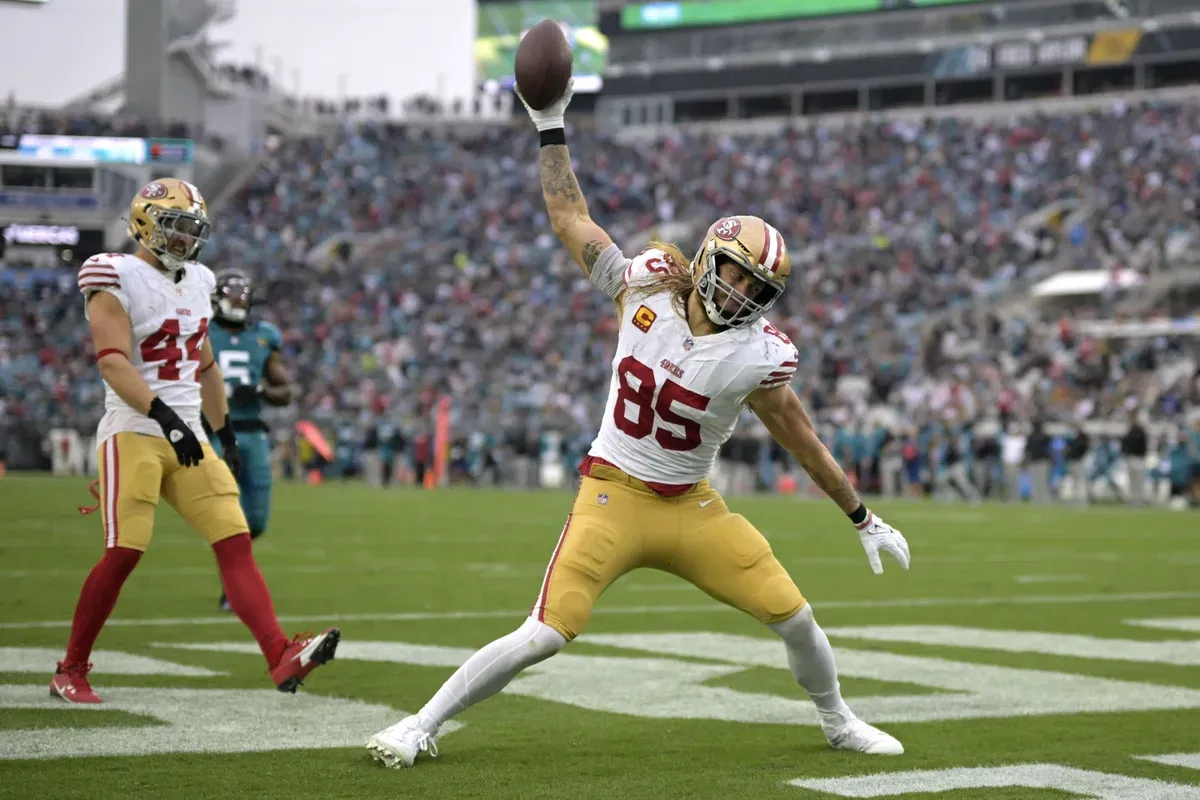
Tight End Dart Throws with TD Upside
Last week I highlighted how Mark Andrews checks all the boxes of what we're looking for from a potential impact tight end. Andrews isn't the only option who profiles similarly to previous impact TE seasons, and I covered the other early-round TEs earlier this week. In this post, I'll highlight a few later-round TEs—specifically focusing on their TD upside.
Generally, I think 2023 drafters have done a great job pricing this year's tight ends. Sure, we can quibble about the price of individual players. But the market looks justified in pricing Travis Kelce and Mark Andrews above the rest of the position. And although T.J. Hockenson, George Kittle, Darren Waller, Kyle Pitts, and Dallas Goedert haven't elevated to the level of Andrews and Kelce, they have special receiving traits that can generate huge spike weeks. Several of these players will likely burn us this season, but they all have the necessary upside for the risk, forming a clear top seven at the position. After that group, we see a roughly 20-pick ADP gap, which looks warranted. Because after TE7, the profiles become far less compelling.
Early-Round Predicability
We should expect ADP to effectively identify the elite options at TE. After all, the market's knack for identifying TEs with elite weekly upside is one of the main selling points for the elite TE roster construction.
And we don't even have to give the market that much credit here. The talent gap between the elites and non-elite TEs is typically stark.
Because, while Mark Andrews and Travis Kelce are listed as tight ends... is their impact on an NFL offense at all comparable to Hayden Hurst's?
Last year, Mark Andrews ranked fourth in ESPN's open score among all TEs and WRs, while Kelce ranked 13th. Among the 648 WR and TE seasons since 2017, Andrews and Kelce are coming off the 18th and 47th-best seasons overall. Both players posted top-50 all-time seasons in 2021 as well. Andrews and Kelce are elite receivers. And we would feel that way even if they were listed as WRs.
On the other hand, Hurst has twice logged enough routes to appear in open score. He finished 111th of 113 WRs and TEs in 2020 and 107th of 110 in 2022. Last year's mark was good for 559th of 648 all-time, and that was his better of the two seasons. And yet... Hurst is a starting NFL tight end who looks locked into a meaningful role.
Comparing Hurst to Andrews and Kelce... is almost rude. The dude is being asked to run routes in addition to regularly blocking giant defenders. The fact that Hurst can't run pristine routes isn't that remarkable. What's remarkable is that Andrews and Kelce can.
Late-Round TD Dart Throws
As a fantasy draft progresses, we quickly run out of TEs with genuinely compelling receiving profiles. And talent-based breakout options tend to dry up quickly as well. By the early double-digit rounds, we're typically looking for tight ends who will play more than people think or who will score TDs at a high rate—because, even in tight end premium scoring, TDs drive a ton of value at the position.
Last season, Cole Kmet finished TE16 in receptions and TE13 in yards. But his seven TDs were good for TE4. Kmet finished TE7 in half-PPR, TE8 in PPR, and TE8 in TE premium.
Last season, Juwan Johnson finished TE19 in receptions and TE16 in yards. But he tied Kmet's seven TDs and finished TE11 in half-PPR, TE14 in PPR, and TE15 in TE premium.
TDs aren't everything, but if there were a way to better predict tight end TDs... we'd definitely want to know that.
The Importance of Play Action
We want tight ends who run a lot of routes. But those TEs are usually expensive.
And we want TEs with route-running skills and playmaking ability downfield and after the catch. But those TEs are often the ones running a lot of routes because they add value to real-life passing games.
So it's rare that we have a late-round opportunity to draft a talented receiving TE with an established, previously demonstrated NFL role. Instead, we're often looking at players who profile as unknown talents, products of their offense, or might be in part-time roles.
But not every part-time role is equally valuable.
If the goal is to predict TDs, we should prefer cheap TEs who are involved in the play action game.

Over the last five years, 41% of tight end TDs have occurred on play action passes compared to just 27% of wide receiver TDs. This makes play action route participation highly valuable for TEs. It also makes run blocking an important component of fantasy analysis because run-blocking ability helps TEs access run-fake looks. And I have to imagine that run-blocking ability is especially prized in the jumbo packages some teams incorporate at the goal line.
This TD upside isn't just theoretical. Over the last five seasons, 58 tight ends have scored 5+ TDs. 66% of these seasons have come from TEs who posted 40%+ route participation on play action dropbacks.
However, simply looking at route participation on play action plays only goes so far. As we move later into the draft, we are selecting players with less-than-ideal roles. Generally, we're making bets that these TEs will play more than our opponents expect. Some of those bets will hit, and others won't. But finding players who will hit more dramatically when additional playing time materializes would be helpful.
Play Action Participation Rate
With that goal in mind, I created a metric that divides play action route participation by route participation on all dropbacks. I'll refer to this as play action participation rate (PAPR).
For example, Mark Andrews posted 82% play action route participation last year. And he logged 88% route participation on all dropbacks. So his PAPR was 0.93. Andrews was tied with Zach Ertz with the highest PAPR among full-time TEs last year.
On the other hand, Hunter Henry posted 74% route participation on all dropbacks but was at just 40% on play action. His 0.54 PAPR was the lowest among all TEs with 60%+ route participation.
In fairness to Henry, play action isn't everything. In 2021, he saw eight non-play action green-zone (10-yard line and in) targets, scoring five.
But do I love that Henry has just one scoreless play action green-zone target over the last two seasons? No, I do not.
And when Henry's non-play action green-zone targets cratered to just two last season, it really hurt. Henry scored nine TDs in 2021 but just two last season.
And look, I get that TDs and green-zone targets are highly volatile. But... we know TE targets should more reliably occur on play action—as shown in the chart above. And logically, this effect should increase near the goal line.
Think about it. When a tight end runs a standard route, he is doing something a WR could do. Yes, a TE represents a bigger target for his QB than most WRs. But that might not mean a ton if he can't separate well. On a standard goal-line passing play, a TE isn't a great bet to be the QB's first read... unless he is an elite receiver. Travis Kelce will see plenty of non-play action green-zone targets this year. But that's not because he's a tight end; it's because he's Travis Kelce.
However, when a TE sells a run fake by engaging with a 250-pound run stuffer and then breaks into a route... he is doing something that very few WRs could physically achieve. And there's a decent chance that play is designed to take advantage of the run action by having the QB look to the TE as his first read.
To be clear, I'm not saying there's more fantasy value in a play action target than a non-play action target. There isn't. Targets are targets, and goal-line targets are goal-line targets. They're worth the same regardless of what created them. But for TEs, play action targets at the goal line may be stickier—because those targets play to the relative strengths of the position.
All About That PAPR
Play action participation rate allows us to determine which TEs are seeing a high rate of play action route participation relative to their overall role in the offense. This can help us determine the route makeup of a TE's role as his projected route participation scales up or down.
But the metric doesn't mean much unless it can help identify TE scoring upside. Thankfully, PAPR does appear to help predict TDs.
Of the 58 TEs with 5+ TDs since 2018, 57% of them had a 0.75+ PAPR, including 52% of the 25 TEs drafted in Round 11+.
Last season, a 0.75 PAPR would have been good for 11th among TEs with 60%+ route participation—it's a rate that indicates a lot of involvement in the play action game.
But play action participation rate doesn't tell us much on its own.
For example, Noah Gray's 1.44 was the second-highest mark among TEs last year. That doesn't mean a ton for Noah Gray... unless we had a reason to expect his overall route volume to spike.
Gray projects to remain a part-time player, but there are several late-round TEs who should see significantly more work this season. And the beautiful thing about PAPR is that it can help us project how part-time TE roles will scale with more opportunities.
PAPR Boys
Despite a part-time role in 2022, Chig Okonkwo is a popular double-digit-round TE target. But is the market overly bullish on his 2023 upside?


